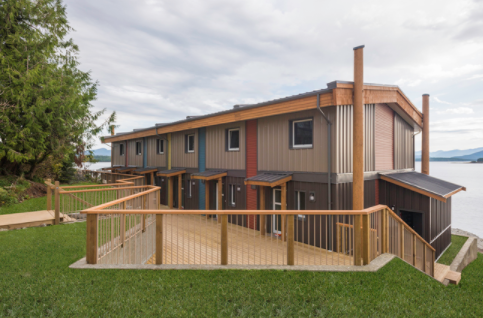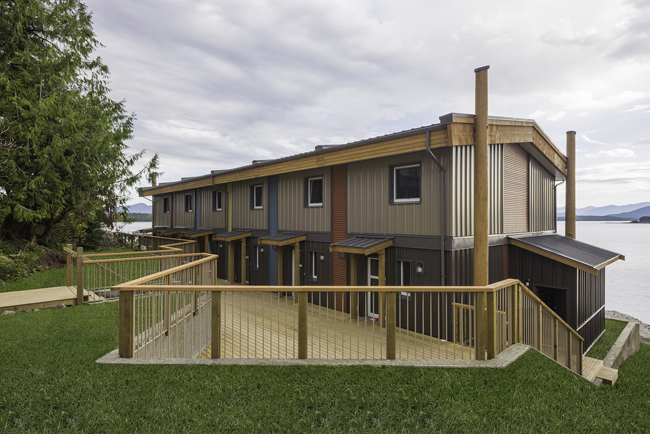
Yale First Nation & Britco team up to create a new generation of energy efficient housing
In the Fall of 2016, Yale First Nation signed on with modular builder, Britco, one of the largest commercial modular construction companies in North America, to start a housing revolution.
For the past few years, Yale, a First Nation located in Yale, BC, with approximately 160 band members living on and off reserve, has been struggling to solve its housing crisis. They have a need, they have funding, but the solutions that existed did not necessarily bring true affordability to the Nation’s 160 band members – specifically those that live on reserve.
Yale First Nation’s existing housing was becoming uninhabitable, with basic structural issues plaguing many members’ homes. Housing that had barely met building codes when it was built 22 years earlier was now structurally unsound. Their homes were literally falling apart.
And substandard housing wasn’t the only issue for Yale First Nation. In winter months, the majority of their community members would have difficulty paying their Hydro bill – which isn’t surprising considering the average Hydro bill last winter came in at $350 a month. This left the Nation helping its members pay those bills and, at times, footing the bill for food and other necessities as well.
Pioneering Passive House
The housing revolution begins with two townhouse complexes for ten Yale First Nation families built to Passive House standards. Passive House standards are currently the highest standards of energy efficiency in a building available in the world today, making Yale First Nation the most energy efficient First Nation in Canada per capita, once the townhouses are complete. This extreme energy efficiency will reduce energy costs by 80 percent, and the members living in the townhouses will see and feel the difference in quality and comfort immediately.

When pairing Passive House standards with controlled off-site modular construction techniques, the quality of the building itself is drastically increased because Britco is able to oversee every step of the construction process to ensure quality and attention to detail. This style of building also helps sound-proof the units, and doesn’t expose materials to inclement weather during the build.
“Poor quality and high operating costs are issues that many First Nations are facing,” said Yale First Nation Chief Ken Hansen. “We hope to help our neighboring First Nations in British Columbia overcome these issues with some of the solutions we’re working on with Britco.”
Through their work together, the Yale First Nation and Britco are striving to make quality sustainable housing with lower operating costs more accessible to Indigenous communities. In some cases, remote communities are relying on extremely costly diesel generators to heat their housing – which takes a financial toll on the Nations, as well as an environmental one.
The Greener Solution
In addition to reducing energy costs, Yale First Nation’s new Passive House townhouses will emit 80% less greenhouse gas emissions than traditional housing – which aligns well with their beliefs in sustainability and stewardship.
“The lowered impact on the environment paired with the drastic savings in energy costs is a solution we hope a lot of communities will turn to,” said Chief Hansen. “We’re setting a standard for other First Nations in Canada in moving forward with this type of housing.”
Although building to Passive House techniques is new to Canada’s First Nations communities, Britco’s first Passive House project was completed in 2015 for Vancouver Coastal Health Authority in Bella Bella, British Columbia.
A Lasting Partnership
With the support of Yale First Nation, Britco is establishing new benchmarks with this project that will be viewed as an achievement never before seen in a First Nation community. Both Yale First Nation and Britco share a vision of long term sustainability, environmental responsibility, energy efficiency, and economic vitality in an on-reserve housing initiative that will undoubtedly serve as a model for Indigenous communities across the province and nationwide.
“There have only been three houses built on Yale First Nation reserves in the past 22 years. The housing need is no secret, and it’s one of my priorities,” said Chief Hansen. “I am proud of the staff and management at both Britco and at Yale First Nation for their dedication to this project, and the development of a lasting relationship.”
As one of the most sustainable and eco-friendly residences in an Indigenous community in North America, the Yale First Nation Passive House will provide the Nation the opportunity to share their stories, successes, and mentor and guide other communities through the process.
